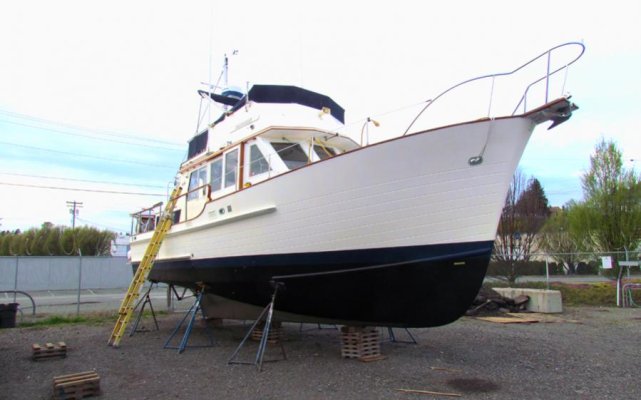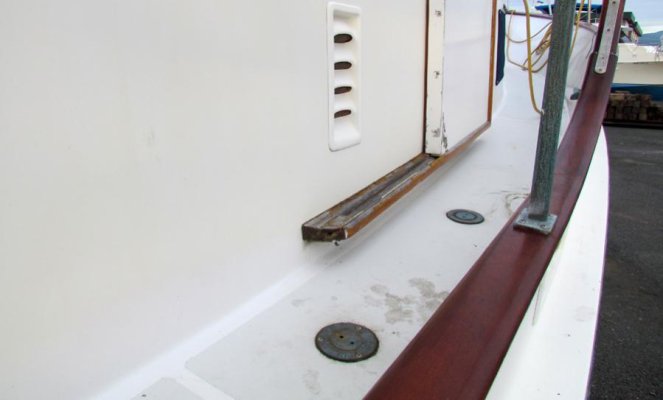In light of the other IG teak decking thread, I took these photos this evening while wandering around the Seaview North yard in Bellingham.
I have in the past mentioned a fellow on our dock who replaced the teak decking on his Island Gypsy himself, did it right, and did a superb job. After removing the teak and prepping the subdeck he applied four layers of glass, then prepped that surface, and applied a non-skid surface. I have stated that not only does his deck look as good or better than what the factory would have done, it's strong enough to land a plane on.
On most boats removing the teak decking reduces the stiffness--- but not the strength--- of the subdeck. So it's proper practice to replace the teak decking with usually two layers of glass on top of the subdeck to restore the stiffness. This guy installed four layers.
Anyway, this fellow, like us, is a refugee from F dock which is being replaced. The port found slips for all of us around the marina so I haven't seen his boat since last fall. But I noticed he was in the yard for bottom paint. So I climbed the ladder and took a shot of his deck. It took him a summer and a half of steady work to do the whole job, and while he told me afterwards that if he'd known beforehand how much work it was going to be he never would have done it, the end result is terrific I think. (The dirt's probably soot from the recent major fire in the marina--- his deck job is immaculate.)
The third shot is of interest to us. The swimstep on his boat is basically the same as ours in terms of its construction and bracing. But he is carrying a 10' Bullfrog--- a pretty heavy dinghy--- on it. Granted, the motor is carried on a separate mount. But we intend to buy a Bullfrog when we eventually get the time to take longer cruises (month to several months) up north. We had figured to tow it, but it's interesting to see one being carried successfully on a swimstep.
I have in the past mentioned a fellow on our dock who replaced the teak decking on his Island Gypsy himself, did it right, and did a superb job. After removing the teak and prepping the subdeck he applied four layers of glass, then prepped that surface, and applied a non-skid surface. I have stated that not only does his deck look as good or better than what the factory would have done, it's strong enough to land a plane on.
On most boats removing the teak decking reduces the stiffness--- but not the strength--- of the subdeck. So it's proper practice to replace the teak decking with usually two layers of glass on top of the subdeck to restore the stiffness. This guy installed four layers.
Anyway, this fellow, like us, is a refugee from F dock which is being replaced. The port found slips for all of us around the marina so I haven't seen his boat since last fall. But I noticed he was in the yard for bottom paint. So I climbed the ladder and took a shot of his deck. It took him a summer and a half of steady work to do the whole job, and while he told me afterwards that if he'd known beforehand how much work it was going to be he never would have done it, the end result is terrific I think. (The dirt's probably soot from the recent major fire in the marina--- his deck job is immaculate.)
The third shot is of interest to us. The swimstep on his boat is basically the same as ours in terms of its construction and bracing. But he is carrying a 10' Bullfrog--- a pretty heavy dinghy--- on it. Granted, the motor is carried on a separate mount. But we intend to buy a Bullfrog when we eventually get the time to take longer cruises (month to several months) up north. We had figured to tow it, but it's interesting to see one being carried successfully on a swimstep.
Attachments
Last edited:



